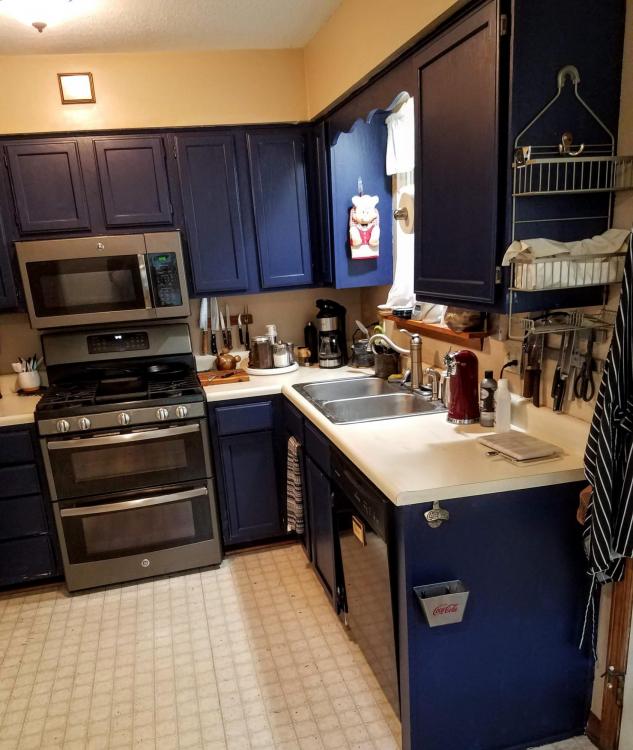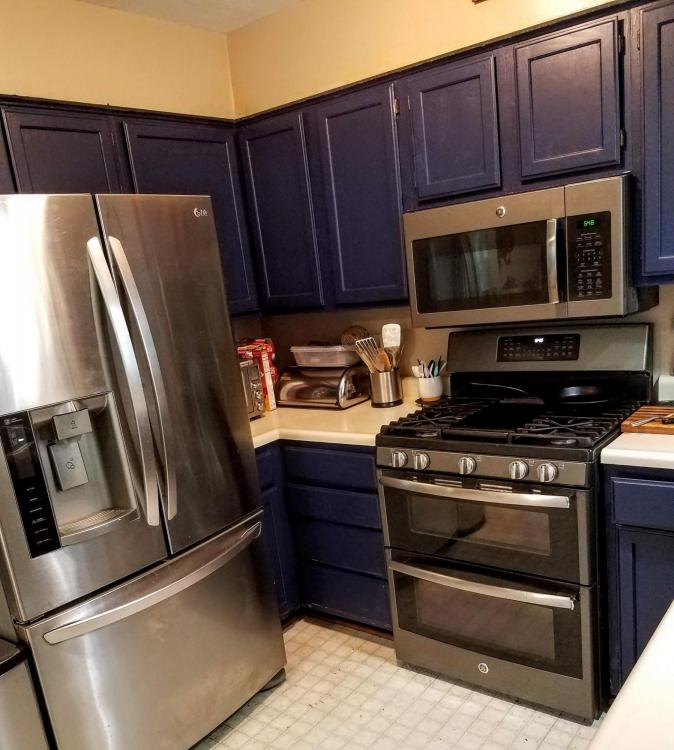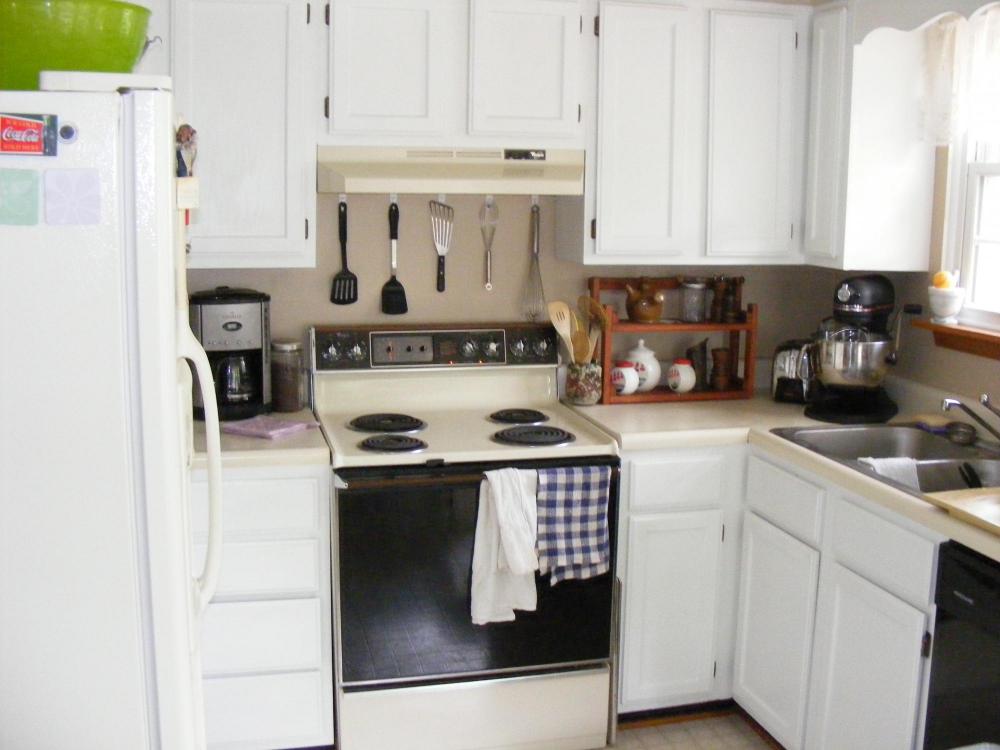Search the Community
Showing results for tags 'Kitchen Renovation'.
-
I'm interested in people's experience using the 12" Gas Char-Grill on Viking Stoves. Does it work well? Is it worth the effort to clean up? Do you spend the extra bucks for the extra 12" and then never use it after the first time? We are redesigning our kitchen ... and are at the decision point between 36" & 48" stove. We're planning to get the Griddle ... but the the Grill will probably tip the balance one way or the other.
-
Kitchen remodeling is something that most of us have either done or at least seriously contemplated. It’s an agonizing process and a strain on any relationship. The thought behind this thread is that the more practical help we can get on kitchen remodeling the better. The inspiration for this thread was when I realized that I know of 5 kitchens that have recently had complete remodels; each is very nice & each is very different. So, I talked to our friends & got their permission to photograph their kitchens and for them to answer a series of questions. I also have their agreement to answer any questions that you may have. (The answers will come through me as I want to maintain privacy for my friends.) In each post there will be a complete description of the kitchen along with lots of photos. In addition here is a list of standard questions I intend to ask. Q. What was your kitchen before it was a kitchen? Q. How large is the kitchen? Q. What kind of cooking do you do? Family? Dinner parties? Ethnic? Gourmet? Q. What were the 3 top goals for your new kitchen? Q. What was the biggest problem that had to be over come? In the design phase ? During actual construction ? Q. What are you most pleased about in your new kitchen? Q. Least pleased about? Q. If you were doing your kitchen again what would you change? What I’m looking for with this initial thread starting post is feedback. How much interest is there in the topic? Are there other questions I should be asking? Would anybody else like to write up their kitchen once they’ve seen these write ups? I’ll be starting with our own kitchen so here’s a teaser picture.
-
I'm hoping to finally get the kitchen I've always wanted which is going to include a gas powered 6 burner rangetop (or 4 burners and an infrared grill) and double wall convection ovens (possible one w/steam) I've been looking at Wolf's 6 burner and 4 + infra red grill, I decided to look for reviews and the most recent ones I can find on here are around 6 years old. Anything else I should be looking at from other makers? In the past there were complaints about the infrared grills failing (if you want to grill, go outside), still the case? I am a bread baker, is a steam oven worth it? Willing to sit back and listen to all recommendations. thanks, Rob
-
Good Morning everyone -- As previously discussed in the Kitchen Photos Forum, I am going to start a forum on the progress of my Kitchen Rehab -- Old photos of my kitchen can be found here: http://forums.egullet.org/topic/148589-kitchen-photos/?p=1971912 - That kitchen, as you can see below, is gone. This process has been challenging to say the least -- Working in our living room with just a microwave and induction burner has been fun -- kind of like camping since we don't have heat right now either and it is starting to get cold at night! We are hoping to be done by around Thanksgiving, but I am not planning on cooking this year. Some highlights of the future kitchen will be soapstone countertops, a butcher block island, a wolf steam oven and bluestar salamander (both of which have been sitting in my garage for better than a year). We are hoping this is our last remodel for a very, very long time!
-
I know I should start with photos of the kitchen but I can not find the "before " I promise I will post them when I do but the hole I am living with will be more profound with some before photos LOL…oh well this is the best I have for now ….and the best I have is what I was so excited and anxious about ..it is my brand new concrete countertops! wow they are done and I am so grateful and happy with the results my husband and his partner did a fantastic job! … as of now Both of the concrete countertops have been poured…. I could scream with joy! ..for a grand total of $200 I now have custom concrete countertops that anyone would be very proud of ! they look just beautiful and will out live me for sure very happy with this ..once they are cured and cleaned up and installed they will be a nice slate gray here is the sink side the other side is the same but the cooktop will go in instead of the sink /penny tiles in progress with a nickel boarder
-
Thanks to the good folks on Egullet, I will be installing a 36" induction cooktop into my new kitchen. But I am really stumped as to what hood to purchase. Since induction does not produce the heat and vapor gas does, it does not require high power. The problem is I'm not able to check these units out in person so am at the mercy of wildly divergent online reviews. Please help! I'm looking for undercabinet with 400 - 600 cfm. Good light. Reasonably quiet and quietly attractive. Budget in the $400 - 600. Would love to hear from induction owners about what works for them.
-
Here's a picture of the current kitchen. The microwave and fan died about 4 years ago. The stove and oven died about 8 weeks ago. Cabinets are 80's oak. Decided it was time to bite the bullet and spend the money to get a new kitchen. Demo/construction will start after Thanksgiving and won't be finished until after New Year. I thought you may enjoy the ride. It's a galley kitchen in a condo so have to work with existing space but I think I'm getting more counter space which is great
-
HI guys, I'm here for a bit of advice. We are building a house (in Croatia, Europe), and finally have a chance to build a kitchen as i want it We would like to get a professional combi oven, something like this new Rational (a bit pricey) or this UNOX (better price) so that we have a long term solution for our needs. The reason we are going for the professional oven is that, for example UNOX, is cheaper than "home combi ovens" from brands like Miele, Gaggenau, etc. and are much better than those. Does anyone have any experience with pro combis at home? i have only seen a couple of people, at least on the internet, that have them at home. I guess that setup would not be a problem, because we designed a water inlet and outlet for the oven, and the voltage is OK. is there anything we didnt think of? Will that oven have higher maintananace cost, even if its used only couple of days a week? Thanks for help P
-
Hi folks! We are redoing our kitchen and while we know what we're doing most everywhere, it turns out we need to upgrade our existing range hood to something new and we know nothing whatsoever about them. We're in an apartment, so it needs to be a non-venting hood. Does anyone have one they really like (and why?) Price not an object here at all. It's for a 36" range if that matters at all. Thanks!
-
For economic reasons we've had to defer a lot of maintenance items in our home. We can now start. We are planning on selling and relocating on another state, hopefully next year. Item one on our list is the kitchen. This is not a remodel, just all new surfaces. We've elected to reface our cabinets. My (still hoping) Blue Star range will be after we move. I had a misguided and idealistic expectation that we would go to Home Depot, pick out everything we wanted in one trip and proceed. This is not to be. You can stop laughing any time. We don't need any new appliances so that part is simple. I didn't take any before pictures but it's a typical California tract home built in the 80s. Because this is going to take WAY longer than I expected we're working on the front bathroom in tandem. We have a relative that was an employment victim of COVID 19 so we're paying for some much-needed labor to help us along. Oh, and I really HATE painting. In the kitchen we've stripped off the 25+ y/o wallpaper and are prepping the walls for a primer coat. Tomorrow we'll start on cleaning and sanding the ceiling. The biggie in the kitchen is repairing the wall behind the sink. There's a bit of black mold to deal with but I've purchased the right PPE and can handle that. Wish us luck.
-
Looking for your opinions and experiences... I am planning to put some wire shelving in my chocolate & confections kitchen. The kitchen has a concrete floor. This shelving will hold ingredients, colored cocoa butters, and packaging. Wondering if I should get casters for this shelving... what are your thoughts on this oh so important question? ;-)
- 20 replies
-
- Chocolate
- Confections
-
(and 1 more)
Tagged with:
-
Hello! I was wondering if anyone on here has tried using an induction cooktop with confection making (caramels, fondant, marshmallows ect...). My stove has literally three settings, and the low setting still burns sugar and there is no such thing as maintaining any sort of "simmer". I was looking into getting a cooktop and buying some copper sugar pots and mauviel makes this thing that goes inbetween. I would love to hear any input into this idea or your experiences! ~Sarah
- 2 replies
-
- Chocolate
- Confections
-
(and 3 more)
Tagged with:
-
I have a 90 year old house. When I bought it, the kitchen was a 1965 remodel. It was broken and dysfunctional, but the light bulb .... yes, one light bulb ... worked well. I did almost all the work myself, from design to finding appliances to designing and commissioning cabinets to making the counters. The marmolium floors are awesome. The PaperStone counters are temperature tolerant to 380ºF and feel like soapstone, but I was able to cut them with woodworking tools. Before ... yes, that's a Litton MicroRange ... Ugh! But a couple months and few dollars later, I have a place I love working in. Lots of new outlets. Massive counter space. What isn't shown is the mobile cutting board I built on top of an old French baker's table, which normally sits between the fridge and the sink. Of course, the counters are full of stuff now: coffee roaster, bean grinder, drip brewer, sous vide, knife block, ... the usuals.
-
It's been awhile since I've been here as I decided to finally downsize homes last Fall. Closed in January and renovations are still on going. Walls between dining, living, kitchen, and breakfast area are gone and 1 Ft beams are now in place as supports. It's been rather busy but have really enjoyed it. This has afforded me to design a kitchen from scratch. Most importantly the appliances were delivered last week and are to be installed this coming week. Wanted to share a pic of the stove. Still much work to go as the second phase of the house starts in early May. Enjoy. 48" Capital Precision Series -- 4 burner 24" griddle
-
Hi, I'm David. I'm in the process of starting a new venture, and need some advice. I'm starting a catering company to cater to 4 golf courses, and hope to expand into other offsite catering after a year or so. I'm looking for a space to put a central kitchen to cook everything, and truck it out from there. We will be serving about 1200 people per weekend. Im having trouble visualizing how big of a kitchen space I'm going to need, and am having trouble finding anything online to help calculate the size of said space. Any help or advice would be greatly appreciated. Thanks in advance, Chef David
-
https://www.bonappetit.com/story/brads-favorite-appliance-dustbuster I don't think I'll be eating at Brad's...
-
She's already always listening, mining and snitching you out. But now she's prepared to nuke Fluffy if you're too squeamish: https://www.theverge.com/2018/1/4/16849306/alexa-microwave-oven-controls-added-ge-kenmore-lg-samsung-amazon
-
We’ve lived in our house for about twelve years and did a small extension not long after we moved in. With our growing family (son number two arrived this July) we wanted to get a bit more living space so started looking at options about a year ago. We have a late Victorian house with a separate dining room, as nice as this is it’s been a big waste of space - we probably used it two or three times a year. So the plan was to extend the kitchen to add a decent sized dining area and free up the dining room for something better. The kitchen we had is under ten years old so we’ve decided to keep some parts of it, adding new worktops, a large rangetop and a breakfast cabinet with pocket doors to hide away the toaster and coffee machine. We’re about halfway through the build at the moment so thought I’d post up some pictures of our progress. Hopefully we’ll be finished this side of Christmas... hopefully!
-
I've started a few topics about various renovation related subjects (here and here), but figured I'd put the overall project in its own. Pix often tell the story even better... It helps to have these. Well, you need to have these if you expect to get anything done in your coop. Then stuff can start... And then start getting rebuilt. A little better electrical system. New pipes have to be done in the walls. This Started on September 8th. They've had approximately 25 days on which work was done. Proceeding along nicely, I'd say.
-
I. Introduction This article reviews the 3500W all-metal commercial induction single-hob hotplate by Panasonic, which I believe is the first “all-metal” unit to hit the U.S. market. Where appropriate, it is also compared with another commercial single-hob, the 1800W Vollrath Mirage Pro Model 59500P. Some background is in order. Heretofore, induction appliances would only “work” with cookware which is ferromagnetic. Bare and enameled cast iron, carbon steel, enameled steel and some stainless steels were semi-dependable for choices, and the cookware industry has worked hard to make most of its lines induction compatible. But alas, not all cookware, past and present, has worked; copper and aluminum don’t, at least without a separate interface disk or it’s own ferromagnetic base layer. The reason why non-ferromagnetic cookware hasn’t worked on induction is technical, but it relates to the magnetic field and what’s called the “skin depth” of the pan’s outermost material. With copper or aluminum, the field will not excite the metals’ molecules to the extent that their friction will generate useful heat to cook food. And the way the appliances come equipped, unless the appliance detects something sufficiently large and ferromagnetic, they will not produce any field at all. Therefore, to the consternation of many cooks, pro and amateur, older (and in the opinion of some, better) cookware needs to be retired and replaced if/when they wish to switch to an induction appliance. Some cooks don’t mind, but others who, like me, have invested heavily in copper and are habituated to it and aluminum, would forego induction altogether rather than discard our cookware. But what we’ve really meant—all along--when we say or write that only ferromagnetic cookware will “work” on induction is that the frequency chosen for our appliances (20-24kHz) will not usefully excite other metals. If that frequency is increased to, say, 90-110kHz , then suddenly the impossible happens: aluminum and copper, with absolutely no ferromagnetic content, will heat in a way that is eminently useful in the kitchen. While Panasonic has made dual-frequency induction hotplates available in Japan for several years now, they didn’t make it available here until recently (My unit indicates it was manufactured in early 2016!). I speculate the reason for the delay relates to the detection circuitry and the switches that determine the frequency at which the field will operate. The introduction of all-metal induction in USA is especially interesting because it allows a direct comparison of cookware of all (metal) types. For instance, cookware nerds have long debated how copper cookware on a gas compares with disk-based stainless on induction. While the veil has not completely lifted (for that we would need extremely precise gas energy metering), we now have the ability to measure and compare copper, aluminum, clad and disk-based on the same induction hob. II. Dimensions, Weight & Clearances The Panasonic, being a true commercial appliance, is considerably larger than most consumer and crossover hotplates. It stands 6 inches tall overall, and on relatively tall (1.25”) feet, so that there is space for ample air circulation under the unit. It is 20.25 inches deep overall, including a standoff ventilation panel in back, and the angled control panel in front. It is 15” wide, and weighs in at a hefty 30.25 pounds. Suffice it to say, the Panasonic is not practically portable. The KY-MK3500’s Ceran pan surface is 14.25 inches wide by 14.5 inches deep, almost 43% larger in area than the VMP’s glass. Panasonic tells me they have no recommended maximum pan diameter or weight, but the tape tells me that a 15” diameter pan would not overhang the unit’s top (Compare the VMP, which can accept a maximum pan base of 10 7/8”). Common sense tells me that—unless the glass is well-braced underneath in many places, 25-30 pounds of total weight might be pushing it. For those who might consider outfitting their home kitchens with one or more of these units, in addition to having 20 amp 240v (NEMA #6-20R receptacles) electrical circuits for each appliance, 39 1/2 inches of overhead clearance is required to combustible material (31 ½” to incombustibles) and 2 inches to the back and sides (0” to incombustibles). The overhead clearance requirement and the tall 6” unit height call for no (or only very high) cabinetry and careful design of a “well” or lower countertop/table that will lower the Ceran surface to a comfortable cooking height. In other words, a tall pot on this unit on a regular-height counter might be a problem for a lot of cooks. III. Features A. Display The KY-Mk3500 has an angled 8-key spillproof keypad and red LED numerical display. The keys are large, raised and their markings are legible. All but the four Up/Down keys have their own inset indicator lights, which indicate power, mode and memory operation. The numerical display is large and bright. The numerical display area is divided between time (XX:XX) to the user’s left and power/temp to the user’s right. If the timer or program features are activated, the numerical display shows both the set time and the power/temperature. There is also a small “Hot Surface” LED icon on the panel. The Panasonic also actually uses the Ceran surface as a display of sorts. That is, there is a lighted circle just outside the faint positioning circle, which glows red whenever the unit is operating, awaiting a pan, or the Ceran is hot. Panasonic also claims that this display also changes brightness with the set power level, implying that the operator can judge the heat setting by a glance. Thus this display serves three purposes: (a) pan positioning; (b) burn safety; and (c) intensity. B. Safety Features As one would expect, there are a variety of safety features built into this appliance. In most cases, these features are controlled by detection circuits, some fixed, some defeatable/variable. This being a commercial unit, Panasonic has set the unit’s defaults with commercial users’ convenience in mind. If consumers want the full spectrum of safety settings, they need to vary these defaults. For instance, if a home cook wants to make sure the unit powers off if the pan is removed and not replaced within 3 minutes, they have to manually vary a default. Likewise if the operator wants the power to automatically shut off after 2 hours of no changes. But others, like the basic “Is there a pan there?” detection and overheat shutoff, are there no matter what and cannot be defeated. C. Settings & Programming The KY-MK3500 features both power and temperature settings. For “regular” induction, there are 20 power settings, which range from 50 watts to 3500 watts. For non-ferromagnetic pans, there are 18 power settings, which range from 60 watts to 2400 watts. The display shows these settings in numerals 1-20 and 1-18 respectively. When the power is toggled on, the unit defaults to Setting 14 in both frequencies. The temperature settings are the same in both modes, with 22 selectable temperatures from 285F (140C) to 500F (260C). Other than for the very lowest temperature setting, each setting increase results in a 10F temperature increase. Usefully, the display shows the set temperature, not 1-22; and until the set temperature is reached, the display indicates “Preheat”. The unit beeps when it reaches the set temperature. The Panasonic measures pan temperature using an IR sensor beneath the glass; this sensor sits about 1 inch outside the centerpoint of the painted positioning markings, yet inside of the induction coil. The timer operation is fast and intuitive. Once the power or temperature is set and operating, the operator merely keys the timer’s dedicated up/down buttons, and the timer display area activates. Timer settings are in any 30-second interval between 30 seconds and 9 ½ hours, and the display will show remaining time. The beeps at the end of cooking are loud. There are nine available memory programs, which can be set for either power or temperature, along with time. Programming entails pressing and holding the Program mode button, selecting the program (1-9), then picking and setting the power or temperature, then setting the timer, and finally pressing and holding the Program button again. After that, to use any of the entered programs, you simply press the Program button, select which program, and the unit will run that program within 3 seconds. In addition to Heat-Time programmability, the KY-MK3500 also provides the ability to vary 9 of the unit’s default settings: (1) Decreasing the power level granularity from 20 to 10; (2) Changing the temperature display to Celsius; (3) Enabling a long cook time shutoff safety feature; (4) Enabling the main power auto shutoff feature; (5) Disabling the glowing circle; (6) Lowering or disabling the auditory beep signals’ volume; (7) Customizing the timer finish beep; (8) Customizing the Preheat notification beep; and (9) Customizing the interval for filter cleanings. D. Maintenance The KY-MK3500 has a plastic air intake filter which can be removed and cleaned. This is not dishwashable. This filter is merely a plastic grate with ¼” square holes, so it is questionable what exactly —besides greasy dust bunnies—will be filtered. Panasonic recommends the filter be cleaned once a week. Besides that, the Ceran surface and stainless housing clean just like other appliances. IV. Acceptable Cookware Panasonic claims the unit will accept cast iron, enameled iron, stainless steel, copper, and aluminum with two provisos. First, very thin aluminum and copper may “move” on the appliance. And second, thin aluminum pans may “deform”. Panasonic does not address carbon steel pans, but I verified that they do indeed work. They also warn of the obvious fact that glass and ceramics will not work. Buyers are also warned against using cookware of specific cookware bottom shapes: round, footed, thin, and domed. Trying to use these, Panasonic warns, may disable safety features and reduce or eliminate pan heating. As far as minimum pan diameter goes, Panasonic claims the KY-MK3500 needs 5” diameter in ferromagnetic pans, and 6” in copper or aluminum ones. My own tests have shown that in fact the unit will function with a cast iron fondue pot, the base of which is only 4 1/8” in diameter, and also works with a copper saucepan, the base of which is almost exactly 5” in diameter. Obviously, the field will be most active at the very edges of such small pans, but they do function. V. Evaluation in Use I can say that not only does the Panasonic KY-MK3500 “work” with copper and aluminum pans, but that it works very well with them. Thermally, thick gauge conductive material pans perform in close emulation of the same pans on gas, even though there are no combustion gasses flowing up and around the pan. I found this startling. Nevertheless, a searching comparison between copper and ferromagnetic pans on this unit isn’t as straightforward as one might expect. The Panasonic is capable of dumping a full 3500 watts into ferromagnetic pans, but is limited to 2400 watts for aluminum and copper. Despite copper’s and aluminum’s superiorities in conductivity, that extra 1100 watts is going to win every speed-boil race. I initially thought I could handicap such a race simply by using the temperature setting and comparing the times required to achieve a “preheat” in a pans of cold water. Alas, no—the Panasonic’s IR function signified the copper pan was preheated to 350F before the water even reached 70F! Obviously, the entire thermal system of cold food in a cold pan needs to come to equilibrium before the Panasonic’s temperature readout becomes meaningful. A. Temperature Settings Unfortunately, with every pan I tried, the temperature settings were wildly inaccurate for measuring the temperature of the food. I heated 2 liters of peanut oil in a variety of pots, disk-base, enameled cast iron enameled steel, and copper. I thought it might be useful to see how close to 350F and 375F the settings were for deep frying. The oil in a Le Creuset 5.5Q Dutch oven set to 350F never made it past 285F, and it took 40:00 to get there. I kept bumping up the setting until I found that the setting for 420F will hold the oil at 346F. A disk-based pot didn’t hit 365F until the temperature setting was boosted to 400F. The only pan which came remotely close to being true to the settings was a 2mm silvered copper oven, which heated its oil to 327F when the Panasonic was set for 350F, and 380F when set for 410F. The temperature function was a lot closer to true when simply preheating an empty pan. With a setting of 350F, all the shiny stainless pans heated to just a few degrees higher (about 353-357F) and held there. This is useful for judging the Leidenfrost Point (which is the heat at which you can oil your SS and have it cook relatively nonstick) and potentially for “seasoning” carbon steel, SS and aluminum, but not much else, since it doesn’t translate to actual food temperature. There’s also the issue of the temperature settings *starting* at 285F, so holding a lower temperature for, e.g., tempering chocolate or a sous vide bath, or even a simmer would be by-guess-by-golly just like any other hob—your only resort is lots of experience with lower *power* settings. With heat-tarnished copper, a 350F setting resulted in a wide swinging between 353F and 365F, which I attribute to the copper shedding heat far faster than the other constructions, once the circuit stops the power at temperature. Then, when the circuit cycles the power back on, the copper is so responsive that it quickly overshoots the setting. Aluminum, on the other hand, *undershot*, the 350F setting, registering a cycle of 332-340F. I conclude that the IR sensor is set for some particular emissivity, probably for that of stainless steel. If true, the Panasonic, even though it automatically switches frequencies, does not compensate for the different emissivities of copper and aluminum. And even if Panasonic added dedicated aluminum and copper IR sensors, there is enough difference between dirty and polished that the added cost would be wasted. Bottom line here: the temperature setting mode is of extremely low utility, and should not be trusted. B. Power Mode – Pan Material Comparisons Given the differences in power setting granularity and maximum power between the two frequencies, it is difficult to assess what X watts into the pot means in, say, a copper-versus-clad or –disk showdown. What is clear, however, is that Setting X under disk and clad seems “hotter” than the same setting under copper and aluminum. I will need to precisely calibrate the Panasonic for wattage anyway for the hyperconductivity project, so I will obtain a higher-powered watt meter to determine the wattage of every power setting for both frequencies. Until then, however, the only way I can fairly handicap a race is to apply a reduction figure to the ferromagnetic setting (2400W being 69% of 3500W). Given that we know the wattage at the maximum settings, we can infer that Setting 14 (actually 13.8) on the 20-step ferromagnetic range iis approximately the same heat output as the maximum setting (18) for copper/aluminum. The boil times for 4 liters of 50F water in 10” diameter pots shocked me. The 10” x 3mm tinned copper pot’s water reached 211F in 36:41. Not an especially fast time at 2400 watts. The 10” disk-based pressure cooker bottom? Well, it didn’t make it—it took an hour to get to 208F and then hung there. So that left me wondering if the Panasonic engineers simply decided that 2400 watts was enough for copper and aluminum. I have a theory why the copper pot boiled and the SS one didn’t under the same power, but getting into that’s for another time. C. Evenness Comparisons The wires which generate the induction field are wound in a circular pattern; when energized, they create a torus-shaped magnetic field. The wound coil is constructed with an empty hole at its center. As matters of physics, the magnetic field’s intensity drops off extremely fast as a function of the distance from the coil; a few millimeters above the Ceran, the field is so weak no meaningful heat will be generated. This means that most induction cooktops heat *only* the very bottom of pans, and in a distinct 2-dimensional “doughnut” shape. All of the above can result in a pan having a cooler central spot, a hotter ring directly over the coil, and a cooler periphery outside the coil. It is left to the cookware to try to even out these thermal discontinuities when cooking. Some materials and pan constructions are better at this than others: the successful constructions utilize more highly-conductive metals such as aluminum and copper, but unless the material is very thick, there can be a ring-shaped hotspot that can scorch food. Until the Panasonic arrived to market, hotspot comparisons between ferromagnetic and aluminum/copper pans depended largely on comparing induction’s flat, more discrete heat ring with gas’s more diffuse, 3-dimensional one. Dodgeball-style debate ensued, with few clear conclusions. But now, for the first time, equally-powered flat heat rings in two different frequencies allow us to directly compare evenness in ferromagnetic and aluminum/copper cookware. The simplest and easiest way to assess cookware evenness is the “scorchprint”, which does not require infrared or other advanced thermal imaging equipment. I’ve posted on how to conduct scorchprinting elsewhere, but basically a pan is evenly dusted with flour; heat is applied to the pan bottom. As the flour is toasted, any hotspots visually emerge, giving the viewer a useful general idea of evenness. I will later post the photos of scorchprints I made of 4 different pans run using the Panasonic KY-MK3500: (1) a Demeyere 28cm Proline 5* clad frypan; (2) a Fissler Original Profi disk-base 28cm frypan; a 6mm aluminum omelet pan; and (4) a 32cm x 3.2mm Dehillerin sauté. To make it a fair race, I heated all the pans at 2400W until they reached 450F, and then backed off the power setting to maintain 450F. I did this in order not to compromise my saute’s tin lining. As you will see, both the clad Demeyere and the disk-based Fissler did print the typical brown doughnut, with a cooler center and periphery. By far the most even was the thick, all-aluminum pan, which actually was even over its entirety—even including the walls. The copper sauté was also quite even, although its larger size and mass really dissipated heat; once 450F was dialed in, no more browning happened, even after 30 minutes. I conclude that the straightgauge pans were far more effective at shunting heat to their peripheries and walls (and also to some extent into the air) than the clad and disk-based pans. The latter accumulated their heat with most of it staying in the center of the pans. Eventually, even the “doughnut hole” blended into the scorch ring because the walls were not bleeding sufficient heat away from the floor. This was especially pronounced in the Fissler, the high wall and rim areas of which never exceeded 125F. The aluminum pan, in contrast varied less than 30F everywhere on the pan. D. Other Considerations The Panasonic’s fan noise at the cook’s position was noticeable at 63 dBA, higher than with the VMP’s 57 dBA. These levels are characterized as “normal conversation” and “quiet street”, respectively. Interestingly, I found two other, potentially more important differences. First, the Panasonic’s fan stays on, even after the unit is powered off, whereas the VMP’s fan shuts off immediately when the hob is turned off. Second, the Panasonic’s fan steps down from the louder speed to a much quieter (47 dBA, characterized as “quiet home”) level until the Ceran is cool to sustained touch, at which point it shuts off completely. I think the Panasonic’s ability to continue to vent and cool itself is a great feature, especially since a cook could leave a large, full, hot pan on the glass. The glowing circle is useless for gauging heat setting or intensity. And while it works to indicate a hot surface, it remains lit long after you can hold your hand in place dead center. VI. Summary and Lessons The Panasonic KY-MK3500 is a solid unit, well-conceived and rugged. It is extremely easy to use. It works well with both the common 24kHz frequency used with ferromagnetic cookware, and the 90kHz frequency chosen here for copper and aluminum. It effectively and automatically switches between the two. In my opinion, it points the way to expanding the worldwide induction appliance market to include dual frequencies. It also obviates the need to: (a) junk otherwise excellent cookware merely to have induction; and (b) retrofit designs to bond on ferromagnetic outer layers. In fact, in my opinion, my tests indicate that, in a dual-frequency world, adding ferromagnetic bottoms may well be a drag on pans’ performance. I also consider the Panasonic Met-All to be ground-breaking in what it can tell us about *pans*, because all metallic pans are now commensurable on induction. Clearly (to me anyway), watt-for-watt, the copper and aluminum pans performed better than did the clad and disk-based pans on this unit. Boil times were faster, there was less propensity to scorch, and the conductive-sidewall pans definitely added more heat to the pans’ contents. We may ultimately find that 90kHz fields save energy compared to 24kHz fields, much as copper and aluminum require less heat on gas and electric coil. In terms of heat transfer, the copper and aluminum pans came close to emulating the same pans on gas. And at 2400W/3500W it has the power of a full size appliance in a relatively small tabletop package. The Panasonic is far from perfect, however. It can’t really be considered portable. There are far too few temperature settings, and what few it has are not accurate or consistent in terms of judging pan contents and attaining the same temperature in different pans (and even the same pan unless clean). The luminous ring could easily have been made a useful indicator of intensity, but wasn’t. And it lacks things that should be obvious, including a through-the-glass “button” contact thermocouple, more power granularity, an analog-style control knob, and capacity to accept an external thermocouple probe for PID control. Most importantly for me, the Panasonic KY-MK3500 portends more good things to come. Retail price remains $1,700-$2,400, but I jumped on it at $611, and I’ve seen it elsewhere for as low as $1,200. The manual can be found here: ftp://ftp.panasonic.com/commercialfoo... Photo Credit: Panasonic Corporation
-
We have started into fixing the kitchen after starting planning several years ago - almost as long as the dishwasher has been dead and the oven barely functional. And don't get me started on the non-exhaust fan. Before the destruction but after removing all the crap: The fridge was replaced not too long ago and is staying where it is. We had to have its alcove expanded. Perhaps not the best ergonomic location but it fits. We aren't moving the other appliances or sink very far so are hoping the plumbing and electric are no big deal. End of first day. We caught a couple of things in time. The fume hood and cupboards over the cook-top were set too low. They were going to set the sink as an over-mount when we had bought and under-mount. Apparently it could be done either way but silly us for not making it clear that the sink described as an undermount should be under the counter top. We decide the cupboard to the right of the oven should open the other way so we can get in there when cooking. Our mistake but I hope we can keep the oil, salt, pepper, etc. there rather than cluttering up the counter. The cabinet guy insisted that the cook-top couldn't be centred over the oven. I still don't understand why but not a big deal. It will be easier to get around the island when someone else is cooking but harder to squeeze past into the pantry. It seems to me that the walls should have been re-done before the cabinets went up. I think this was easier on the cabinet guy who is doing most of the coordination but probably will be a pain for the plasterer. And we have some trim issues to work out. Day 2 fixing things, electrical work, and measuring for the countertops. Now we wait for them to be finished before much else can happen. Spock is not impressed.
-
I am in the process of packing up my kitchen—we’re about to demo and remodel—and am sorting about 20 years of accumulated cookery bits into pack/donate/trash categories. Which led me to an article from the expert advisors at Epicurious, “The 9 Kitchen Tools You Need to Replace Every Year,” in which they advocate for an annual household purging of Microplanes, cutting boards, paring knives, dish towels and more (ideally replaced via convenient affiliate links). Two questions (at least) arise from this: How much cheese and nutmeg grating does it take to dull a Microplane? I haven’t noticed a diminution in mine’s powers, and I’m pretty sure it’s at least decade old. Is there anything that you do replace annually on principle, regardless of its condition? For the record, I don't think they're wrong about sponges. (Also, Hello! I’ve been away from eGullet for quite a while and am ineligible to post a Welcome Our New Members Thread, but I’m a domestic dabbler in Portland, Ore. Mostly stovetop and sous vide of late, since my ovens have been out of commission for a few years… looking forward to getting my bake on soon).
-
My new house is in the early stages; it is barely framed up but I'm already dreaming of my dream kitchen. Yesterday I went to our one big appliance store (other than HD and Lowe's) and I think I'm going to go wild with the new units. First up I'm thinking of a Sub-Zero side by side. A Thermador 30" slide-in dual fuel range, a Bosch d/w as well as a new m/w and a new hood of a type yet to be determined. All this is really overkill since I'm by no means a big presence in the kitchen, and these expensive appliances do not define the home which is really rather modest. But I'm figuring this is my last rodeo, if you will. I have heard of some folk having trouble with Sub-Zero repairs so I plan to add a warranty protection plan.. Anyone have any negative experiences with any of these brands?\ ETA: I have been reading reviews online about Sub-Zero fridges and I may have to re-think that choice. Those reviews are not good. Much as I'd like to have a custom-size I'm beginning to have grave concerns about repairs.
-
I saw an episode on the Property Brothers where they did kitchen cabinets in dark blue. I showed Charlie some kitchen like that on line. He liked them too. I have been planning new floor and counter tops but this I could do myself. The job isn't finished but it is far enough along to see how it looks. The next one was taken within a month of so after we moved in in 2012 and the last one is how it looked in April.
-
I need your help guys in organizing my thoughts. It looks like we are going to be moving again, still in Miami this time. The only difference is that we are buying a place for the very first time after 20 years of moving around. It feels premature to me to add picture because, we haven’t signed a contract yet, we only made an offer and it has been accepted. Of course, I am already thinking of what I need to buy for the kitchen. I am not going to renovate the kitchen. It is honestly not the ideal time and even if it’s not my dream kitchen, it has been done 2 years ago. We have an outdoor patio and I am hoping to do a lot of cooking outside, especially at night. So, I am telling you what I have and what for sure I’ll be needing. The cooktop looks vitroceramic and the oven I don’t remember which brand it is but definitely I will replace it. I don’t know yet if I can get gas there but I had one experience with an induction cooktop in the past and it was great. It was Sauter, which is common in France. It was something like this and I wouldn’t mind something similar. So, first induction cooktop, I don’t have a clue of prices out there, if I recall correctly, I spent 500 euros at the time. Second, oven. Let talk about ideal. In this house I have a Wolf oven which allows me to go to 550F, which is really cool so I can make some pizza in teglia. I had a couple ovens in the past that I loved for different reasons. 1. I had a tabletop Cadco oven (Stefania), half sheet 120V with manual, external steam injection and it could reach 550F. Because of the manual steam, it was awesome to make bread with that oven and to make pizza in teglia again. So sorry I sold it for little when I closed my business. But honestly it’s not the first choice for home use, not too pretty or practical to have on the countertop. 2. I had the CSO and I really loved it but doesn’t solve the problem of making bread or pizza in teglia. Now the outdoor I was thinking either the ZioCiro mini , which is really like a miniature brick oven, differently than the Ooni which is another candidate, you can use also for cooking bread or small round trays of food. The Zio Ciro anyway is not big enough for pizza in teglia. I wish I can get an Effeuno honestly. So, I see myself wanting 5 ovens at the same time 😁 A pizza oven for the outdoor but don’t want to spend 3,000 for a bigger ZioCiro. A CSO, a steam oven for bread and an Effeuno for pizza in teglia and and air fryer if it’s not too much to ask 🤣🤣🤣, you got the situation. Ok, I need to make choices. And no, I don’t have a budget yet because it will depend on the final price of the house and some extra work we are doing from a room and a bathroom. And finally, yes, I want also a vacuum chamber, thanks, and would really love to have a irinox blast chiller. I know I am very reasonable The kitchen is not huge and I cannot start cluttering it with my stuff. Maybe something like my Wolf oven that reaches 550F plus a steam function with bread. And a CSO for daily use? Ooni outside or I cannot resist the ZioCiro anyway. Does it should more reasonable. Do you have such an oven to suggest? Thanks









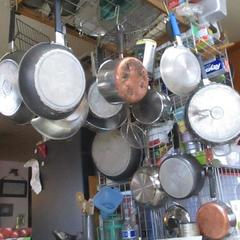

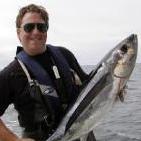
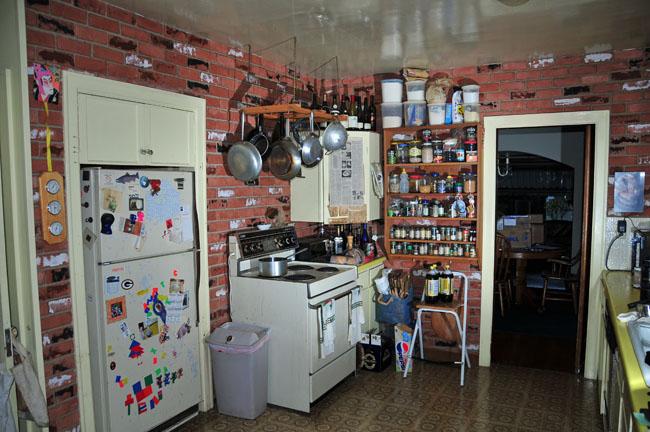
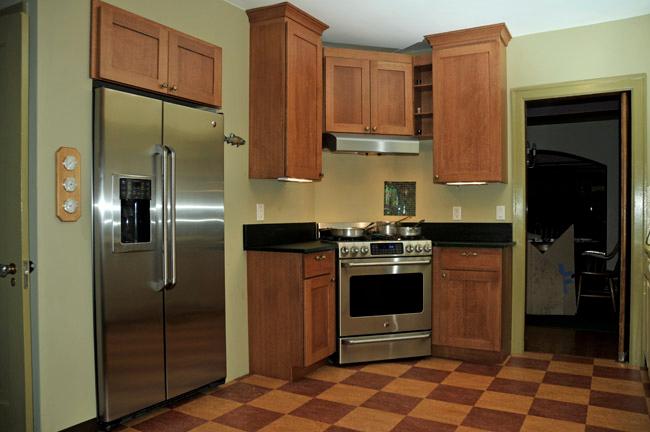
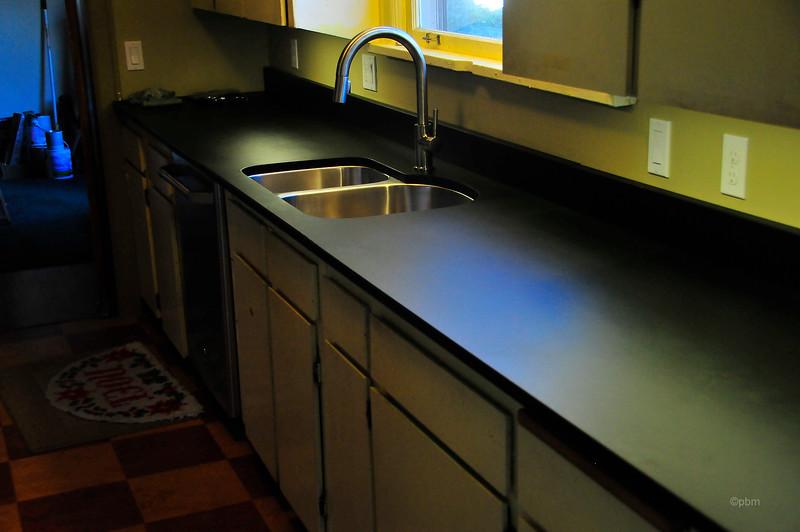

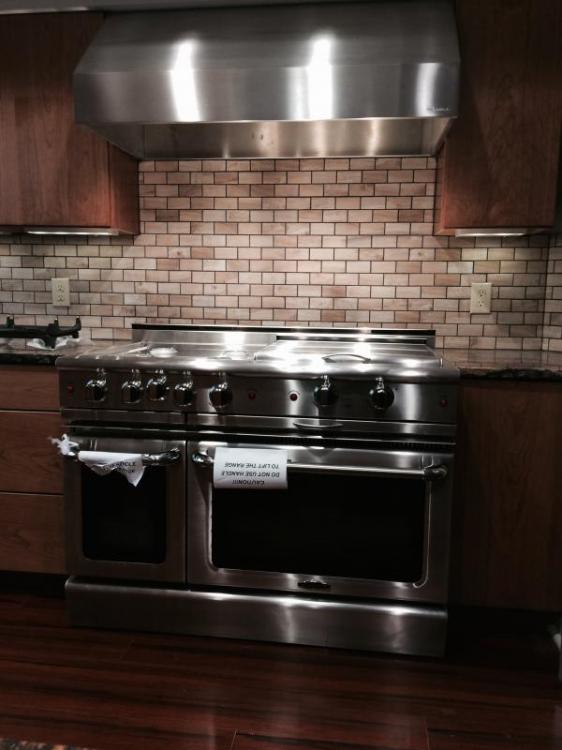


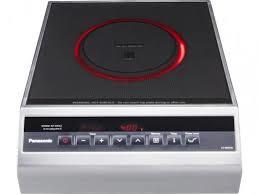


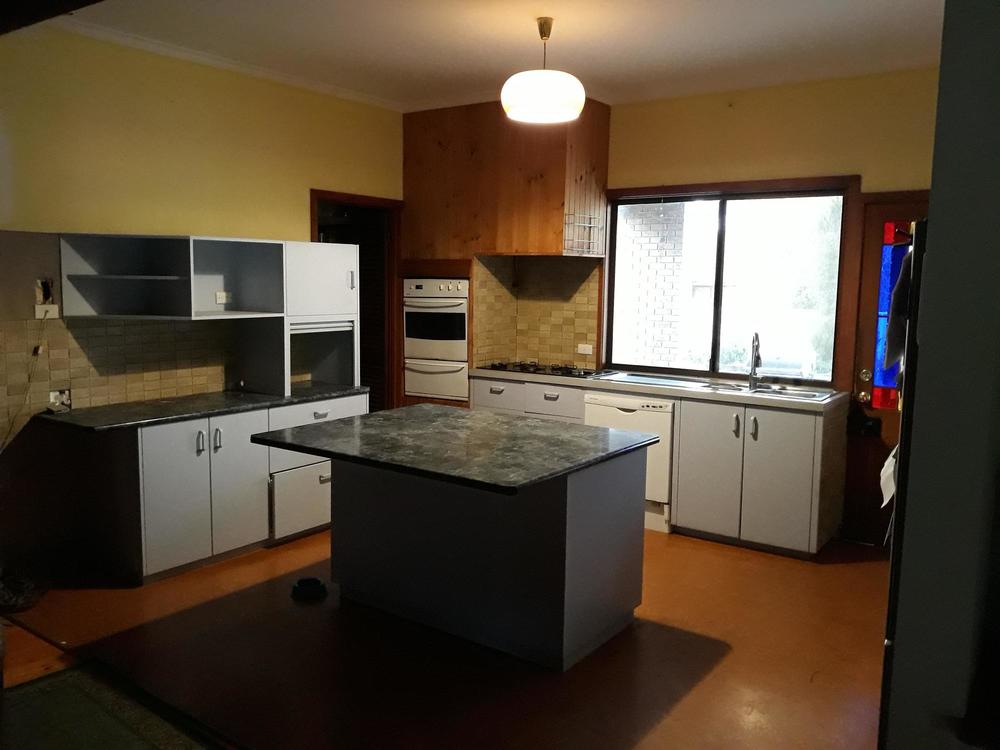
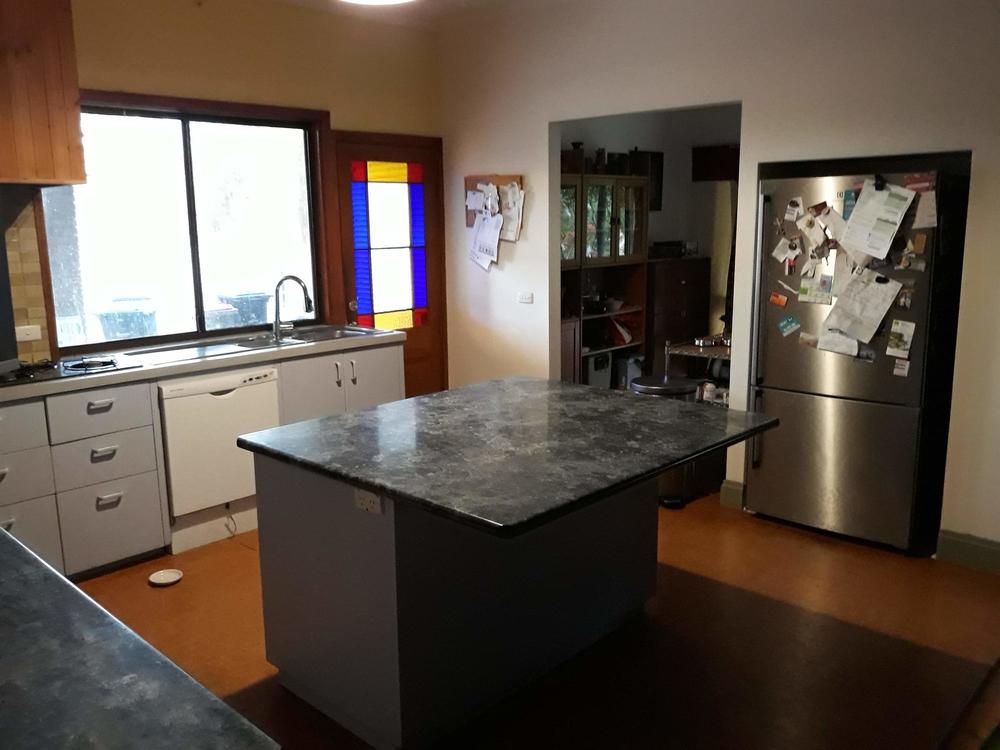

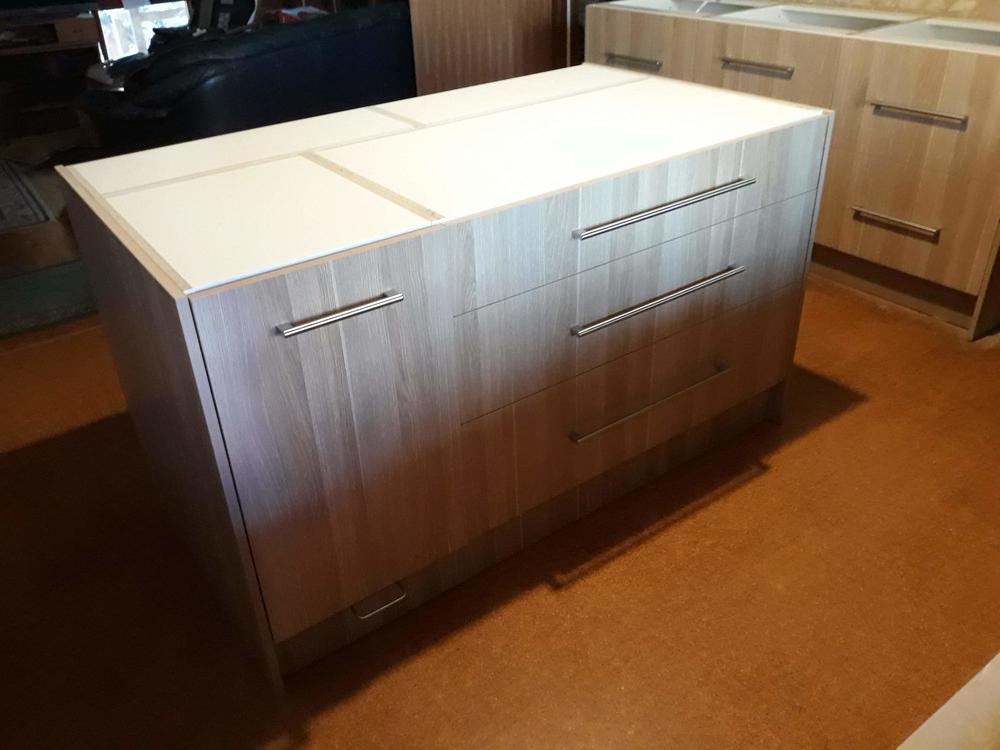
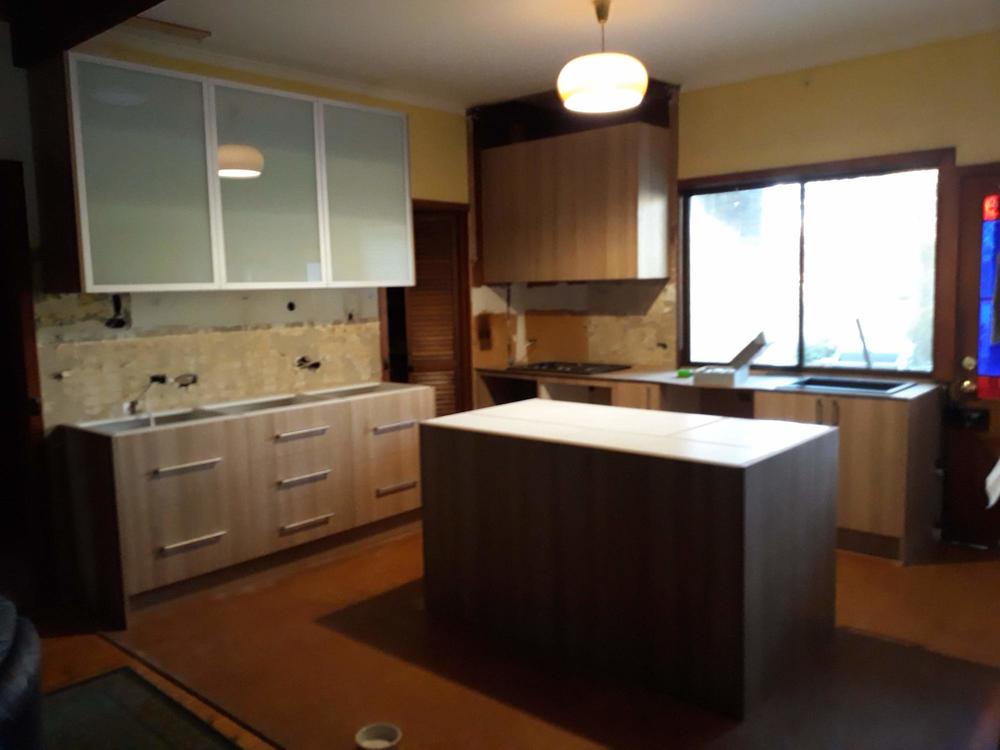
.thumb.jpg.8ee3b41ea463ab0b050853ccffa5e3bc.jpg)



